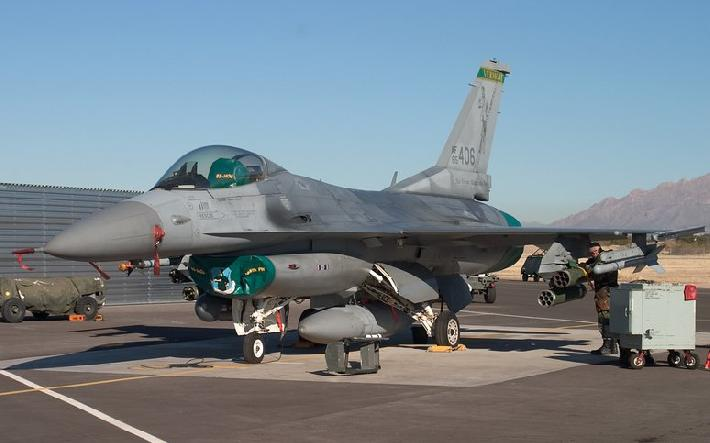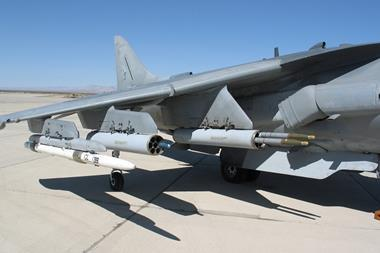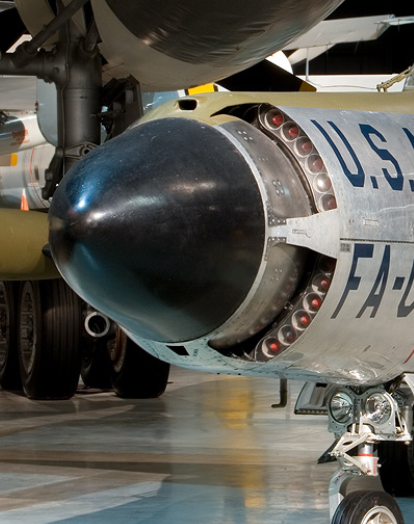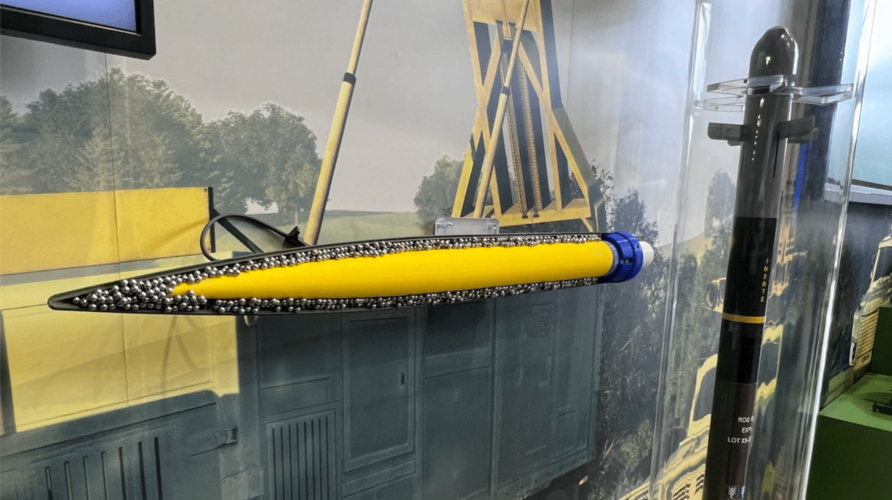You are using an out of date browser. It may not display this or other websites correctly.
You should upgrade or use an alternative browser.
You should upgrade or use an alternative browser.
The APKWS is now capable of shooting down drones
- Thread starter AN/AWW-14(V)
- Start date
aonestudio
I really should change my personal text
- Joined
- 11 March 2018
- Messages
- 2,964
- Reaction score
- 7,483
Forest Green
ACCESS: Above Top Secret
- Joined
- 11 June 2019
- Messages
- 9,476
- Reaction score
- 17,286
Forest Green
ACCESS: Above Top Secret
- Joined
- 11 June 2019
- Messages
- 9,476
- Reaction score
- 17,286
Technically LCITS not APKWS but it seems to best suit this thread.
View: https://x.com/AirPowerNEW1/status/1806751027355672917
View: https://x.com/AirPowerNEW1/status/1806751027355672917
Scott Kenny
ACCESS: USAP
- Joined
- 15 May 2023
- Messages
- 11,553
- Reaction score
- 14,175
Sorry for the late reply, not sure how I missed it.I find that highly doubtful and implausible given that the Allies had succeeded in designing and building proximity-fuses that used sub-miniature valves for AAA shells, if they can survive than then they can survive the G-loads from 2.75" rocket-launch.
You're misunderstanding. It's not about making the fuze survive the launch, it's about how to have that fuze inactive when sitting in the tube, and then activate when the rocket is safely away from the launcher.
The WW2 prox fuzes used metal pins that would shear off under the acceleration forces to do this, but a 70mm rocket has a much softer launch than a 3" gun shell.
Forest Green
ACCESS: Above Top Secret
- Joined
- 11 June 2019
- Messages
- 9,476
- Reaction score
- 17,286

OKSI Secures $6M in Contracts for Advanced Precision Guidance Seeker
Los Angeles CA (SPX) Jul 24, 2024 - OKSI has secured multiple contracts amounting to nearly $6 million from USSOCOM and the Air Force Research Laboratory (AFRL) for their ARMGDN seeker. This seeker is an enhancement to BAE Systems' AP
www.spacewar.com
This seeker is an enhancement to BAE Systems' APKWS laser-guidance kit, enabling passive target acquisition and tracking for precision engagements. The APKWS kit is designed for the 2.75 inch Hydra-70 rocket. Combined, the APKWS with OKSI's ARMGDN seeker allows rapid engagement of various air or ground targets through the ripple fire of multiple precision-guided rockets in quick succession.
By harnessing existing rocket inventories, it dramatically cuts the expense of countering UAS threats, aligning our expenditures nearly 1:1 with the drones they counter.

OKSI Awarded USSOCOM and AFRL Contracts for Precision Guidance Seeker for Munitions - OKSI
LOS ANGELES, July 23, 2024 /PRNewswire/ -- OKSI has been awarded multiple contracts totaling nearly $6 million from USSOCOM and the Air Force Research Laboratory (AFRL) for their ARMGDN seeker. ARMGDN is a capability enhancement to BAE Systems' APKWS® laser-guidance kit, providing passive target...
 oksi.ai
oksi.ai
OKSI is a team of pioneers with over 30 years developing and fielding custom EO/IR sensors within integrated AI/ML.
pathology_doc
ACCESS: Top Secret
- Joined
- 6 June 2008
- Messages
- 1,587
- Reaction score
- 1,507
Subminiaturized solid-state electronics have made the original dream for Sparrow and Sidewinder come true - to graft an affordable homing head and steering system onto an existing unguided rocket projectile.
These are missiles now.
These are missiles now.
Scott Kenny
ACCESS: USAP
- Joined
- 15 May 2023
- Messages
- 11,553
- Reaction score
- 14,175
It would be very interesting to see CCAs and maybe fighters in the next generation, I suspect that we may see aircraft with built in 70mm rocket tubes again like theSubminiaturized solid-state electronics have made the original dream for Sparrow and Sidewinder come true - to graft an affordable homing head and steering system onto an existing unguided rocket projectile.
These are missiles now.
Last edited:
I suspect that we may see aircraft with built in 70mm rocket tubes again like the F-106 had tubes in the weapons bay doors...
Actually it was the F-102A that was fitted to fire the 2.75" Mighty-Mouse rockets.
Scott Kenny
ACCESS: USAP
- Joined
- 15 May 2023
- Messages
- 11,553
- Reaction score
- 14,175
Thank you, fixed.Actually it was the F-102A that was fitted to fire the 2.75" Mighty-Mouse rockets.
I do believe this is the correct thread to post this video in (Please move it if it isn't to the appropriate thread), anyway the US army has started to deploy a counter-drone system which appears to be based on the APKWS:
This is a system which would be of immense help to the Ukrainians in intercepting Shaheed drones.
The US military is set to have a major boost when it comes to Counter unmanned aerial system (C-UAS) capability.
The US Army has received the six MSI Defense Solutions’ (MSI) Electronic Advanced Ground Launcher Systems (EAGLS) to improve its counter-drone capabilities.EAGLS utilizes 70mm laser-guided rockets to neutralize unmanned aerial threats.
This is an important addition since the menace from UAS has expanded in quantity and complexity and an urgent demand for agile, mobile, and cost-effective solutions was felt by the service.
In this video, Defense Updates analyzes how EAGLS could help the US military tackle UAS threats ?
This is a system which would be of immense help to the Ukrainians in intercepting Shaheed drones.
Scott Kenny
ACCESS: USAP
- Joined
- 15 May 2023
- Messages
- 11,553
- Reaction score
- 14,175
IIRC, the IM-SHORAD setup is using some APKWS rockets in either 4-packs or 7-packs, in addition to Stingers and the 30mm with proximity rounds.I do believe this is the correct thread to post this video in (Please move it if it isn't to the appropriate thread), anyway the US army has started to deploy a counter-drone system which appears to be based on the APKWS:
The challenge is that I'm not aware of a proximity fuze for the APKWS, only timed detonation for airbursts. I'm sure they're working on a proximity fuze, though. Probably snag the one used by the Stingers and repackage from 5" to 2.75".
Forest Green
ACCESS: Above Top Secret
- Joined
- 11 June 2019
- Messages
- 9,476
- Reaction score
- 17,286
IIRC, the IM-SHORAD setup is using some APKWS rockets in either 4-packs or 7-packs, in addition to Stingers and the 30mm with proximity rounds.
The challenge is that I'm not aware of a proximity fuze for the APKWS, only timed detonation for airbursts. I'm sure they're working on a proximity fuze, though. Probably snag the one used by the Stingers and repackage from 5" to 2.75".

BAE Systems uses Hydra APKWS rockets with new proximity fuze to shoot down small unmanned aerial vehicles
BAE Systems uses Hydra APKWS rockets with new proximity fuze to shoot down small unmanned aerial vehicles.
FUZE for APKWS – Press Release - TSC
In collaboration with L3-Harris Technologies, TSC is pleased to introduced our new proximity sensor to support the Counter-Unmanned Aircraft Systems (C-UAS) mission. (Image Courtesy of BAE Systems)
Probably snag the one used by the Stingers and repackage from 5" to 2.75".
The Stinger IS 2.75" in diameter and 5" Zuni rocket size MANPAD SAM would be, to say the least, a bit of beast to lug around by whoever is unfortunate to be tasked to carry it
I believe I read a fully passive IR kit was also in the works for Hydra rockets.
That would be good because the modified rockets would be fire-and-forget which SALH guidance isn't.
Speaking of SALH guidance, now that Ukraine has its initial batch of F-16s (With more to follow soon) I wonder if an existing laser-designator pod is available for the F-16 that can be slaved to the F-16's fire-control radar? If so then those F-16s could be equipped with the APKWS which would be perfect for hunting down swarms of Shaheed drones and Russian cruise-missiles such as the AS-15 Kent.
Last edited:
- Joined
- 16 April 2008
- Messages
- 9,601
- Reaction score
- 14,474
IIRC, the IM-SHORAD setup is using some APKWS rockets in either 4-packs or 7-packs, in addition to Stingers and the 30mm with proximity rounds.
The challenge is that I'm not aware of a proximity fuze for the APKWS, only timed detonation for airbursts. I'm sure they're working on a proximity fuze, though. Probably snag the one used by the Stingers and repackage from 5" to 2.75".
I have not seen any IM-SHORAD configured with APKWS. The initial version had 4 Stinger and 2 Hellfire, but as we've seen reported, Hellfire is going away because it's too heavy to manhandle up to the top of a Stryker. The new config seems to be 8 Stinger.
- Joined
- 16 April 2008
- Messages
- 9,601
- Reaction score
- 14,474
Would a ground-launched Hellfire be good at intercepting Shaheed drones and maybe Russian cruise-missiles such as the AS-15 Kent?
I think it's really too slow for AS-15, Maybe Shaheed, if it wasn't so much more expensive than the target. The thinking for including it in IM-SHORAD seems to have been half anti-helo and half self-defense against AFVs.
Maybe Shaheed, if it wasn't so much more expensive than the target.
What about surplus early-model AGM-114s? The US has manufactured the Hellfire in the tens of thousands so it would be a good way to get rid of old Hellfire stock and save the US the cost of de-milling or remanufacturing them.
The thinking for including it in IM-SHORAD seems to have been half anti-helo
It would certainly be a good choice to shoot down Kamov Ka-52 Hokum Bs and Mil Mi-28 Havoc attack helicopters.
Scott Kenny
ACCESS: USAP
- Joined
- 15 May 2023
- Messages
- 11,553
- Reaction score
- 14,175
The biggest one being damage to the missiles caused by tree limbs etc hitting them on the move.There are issues carrying and launching Hellfires. Stingers replace them. Though I would think APKWS would be a great alternative.
That's the (mostly) South Korean LOGIR. https://en.wikipedia.org/wiki/Low-Cost_Guided_Imaging_RocketI believe I read a fully passive IR kit was also in the works for Hydra rockets.
Still an imaging IR seeker that bolts onto a Hydra 70 rocket, though.
I have not seen any IM-SHORAD configured with APKWS. The initial version had 4 Stinger and 2 Hellfire, but as we've seen reported, Hellfire is going away because it's too heavy to manhandle up to the top of a Stryker. The new config seems to be 8 Stinger.
Nor I. And it has no laser to make use of such a missile. If an IR guidance kit becomes available I suspect a future increment or upgrade would include it though; it would probably be cheaper than stinger given the number of hydra rockets just lying around.
General Dynamics is still producing Hydra-70 rockets. They had produced 4M total by 2011. In 2020, they signed a multi-year deal to produce $3.4 Billion (with a B) worth of the rockets.
As far as I can tell, a hydra-70 rocket cost $1200 per all up round in 2018. These things are extremely cheap. At that price, this latest GD contract pays for 2.8M rockets.
Now, many of these rockets are destined for foreign military sales to many of the United States partners. But for the rockets left over for the US, what are they going to be used for besides M-SHORAD via APKSW II conversion kits?

 www.flightglobal.com
www.flightglobal.com

As far as I can tell, a hydra-70 rocket cost $1200 per all up round in 2018. These things are extremely cheap. At that price, this latest GD contract pays for 2.8M rockets.
Now, many of these rockets are destined for foreign military sales to many of the United States partners. But for the rockets left over for the US, what are they going to be used for besides M-SHORAD via APKSW II conversion kits?

US Army buys $3.4bn worth of Hydra-70 rockets
The Hydra-70 is an unguided 70mm (2.75in) rocket. When the BAE Systems Advanced Precision Kill Weapon System (APKWS) II upgrade kit is added it becomes a precision weapon, however.
Contracts for May 29, 2020
Today's Defense Department contracts valued at $7 million or more are now live on Defense.gov.
www.defense.gov
Last edited:
- Joined
- 16 April 2008
- Messages
- 9,601
- Reaction score
- 14,474
Now, many of these rockets are destined for foreign military sales to many of the United States partners. But for the rockets left over for the US, what are they going to be used for besides M-SHORAD via APKSW II conversion kits?
A lot of them will still be for unguided air-to-ground use.
Dilandu
I'm dissatisfied, which means, I exist.
Are there any left?Someone need to keep an eye of those F-89 Scorpion and F-94 Starfire rotting in the desert.
Are there any left?
Outside of museums that's what I was thinking of too.
Forest Green
ACCESS: Above Top Secret
- Joined
- 11 June 2019
- Messages
- 9,476
- Reaction score
- 17,286
A hydra rocket might but the APKWS is more like $20k sadly, but still pretty cheap vs using a SAM against drones.General Dynamics is still producing Hydra-70 rockets. They had produced 4M total by 2011. In 2020, they signed a multi-year deal to produce $3.4 Billion (with a B) worth of the rockets.
As far as I can tell, a hydra-70 rocket cost $1200 per all up round in 2018. These things are extremely cheap. At that price, this latest GD contract pays for 2.8M rockets.
Now, many of these rockets are destined for foreign military sales to many of the United States partners. But for the rockets left over for the US, what are they going to be used for besides M-SHORAD via APKSW II conversion kits?

US Army buys $3.4bn worth of Hydra-70 rockets
The Hydra-70 is an unguided 70mm (2.75in) rocket. When the BAE Systems Advanced Precision Kill Weapon System (APKWS) II upgrade kit is added it becomes a precision weapon, however.www.flightglobal.com
Yep, the APKWS upgrade kit cost about $22,500 in 2018-2019.A hydra rocket might but the APKWS is more like $20k sadly, but still pretty cheap vs using a SAM against drones.
Since 2018, the DOD has ordered a minimum of 140k APKWS kits. Note the percentage splits that were explicitly mentioned in one of the 2018 orders: Air Force (64 percent); Army (26 percent); Navy (8 percent); and FMS (2 percent).
I'm not sure what BAE's current production rate is, but in 2023 they mentioned that they could easily ramp up production to 25k units per year.
Some takeaways from all this:
- General Dynamics is producing 400k hydra-70 rockets per year on a hot production line. Millions of hydra rockets have been delivered in the past 20 years.
- BAE is producing slightly less than 25k APKWS II upgrade kits per year
- Only a small percent of APKWS II kits are going to foreign military sales, assuming that one 2018 order is indicative
- Even if the US is receiving 20k APKWS II kits per year, this is still dwarfed by the procurement of hydra-70 rockets.
Maybe this is just General Dynamics with some good old fashioned MIC/DIB nepotism, securing the multi-billion-dollar contracts for munitions that the US can't use at scale. Happy to be proven wrong if anyone knows why we need all these rockets.
Contracts for September 25, 2019
Today's Defense Department contracts valued at $7 million or more are now live on Defense.gov.
www.defense.gov
Contracts for February 6, 2019
NAVY BAE Systems Information and Electronic Systems Integration Inc., Hudson, New Hampshire, is awarded $225,034,247 for firm-fixed-price delivery order N0001919F2701 against a previously awarded
www.defense.gov
Contracts for June 27, 2018
NAVYThe Boeing Co., St. Louis, Missouri, is awarded a $1,504,995,240 fixed-price-incentive-firm contract that provides for the production and delivery of 22 F/A-18E and six F/A-18F Super Hornets in
www.defense.gov

Successful Testing of BAE Systems' APKWS® Laser-Guidance Kits by US Counter-Drone Office - UASweekly.com
Discover how BAE Systems' APKWS laser-guidance kits, a cost-effective and accurate counter-unmanned aircraft system solution, successfully targets Class 2 and Class 3 drones. With its platform-agnostic nature and 100% effectiveness, learn how the APKWS system is paving the way for fielding...
 uasweekly.com
uasweekly.com
It’s a fair question. Especially for the USAF: I cannot remember the last time I saw pictures of rockets on anything but an A-10, a type it is desperately trying to retire, and those had guidance kits. I cannot remember the last time I saw footage of unguided hydras on any fixed wing aircraft.
Forest Green
ACCESS: Above Top Secret
- Joined
- 11 June 2019
- Messages
- 9,476
- Reaction score
- 17,286
Perhaps there are plans to radipdly increase APKWS production in the event of a war. How many LOGIR kits are produced?
Perhaps there are plans to radipdly increase APKWS production in the event of a war. How many LOGIR kits are produced?
It might be that buying in bulk now is seen as an economical way to have inventory for future kits. That or sandbox war dead cat bounce purchases. But given the low costs involved at these build rates, perhaps it’s just building inventory for future guidance kits before ending or heavily curtailing production.
There’s probably a lot of Ukraine donations to their helo force that are not listed under FMS.
- Joined
- 16 April 2008
- Messages
- 9,601
- Reaction score
- 14,474
It’s a fair question. Especially for the USAF: I cannot remember the last time I saw pictures of rockets on anything but an A-10, a type it is desperately trying to retire, and those had guidance kits. I cannot remember the last time I saw footage of unguided hydras on any fixed wing aircraft.
F-16s with 70mm rockets was a fairly standard CAS loadout in Afghanistan. By late war, they were mostly guided APKWS, but there was still probably a reserve of unguided rockets just in case.
They also get used for air-to-ground gunnery training (or at least the SUU-20 dispenser can carry 4 Hydra as well as 6 dummy bombs.

Forest Green
ACCESS: Above Top Secret
- Joined
- 11 June 2019
- Messages
- 9,476
- Reaction score
- 17,286
...and:

 www.flightglobal.com
www.flightglobal.com


BAE's APKWS rockets go to war on AV-8B Harrier
BAE Systems' laser-guided rocket has been rushed into combat on the AV-8B Harrier, seven months after it was requested by the top brass of the US Marine Corps.

Seems they have one F-94 left:Are there any left?

see here: https://gmap.nl/amarg-arrivals/
But serial number search points to Niagara falls AB:

Last edited:
Forest Green
ACCESS: Above Top Secret
- Joined
- 11 June 2019
- Messages
- 9,476
- Reaction score
- 17,286
- Joined
- 3 June 2011
- Messages
- 18,330
- Reaction score
- 12,203
I've always thought if you took an F-89, made it low-wing with engines and intakes above the wing, a small AESA and IRST in the nose, and then stuff the tanks with APKWS and laser guided Zuni (if we still had Zuni). . . (Not literally an F-89 but I love the layout and giant wing.)Someone need to keep an eye of those F-89 Scorpion and F-94 Starfire rotting in the desert.
View attachment 742556
The future of CCA wvr weapon?
kqcke for you
PUMA PUMA PUMA
- Joined
- 3 November 2022
- Messages
- 1,280
- Reaction score
- 1,689
Similar threads
-
Laser Powers Lockheed Martin’s Stalker UAS For 48 Hours
- Started by seruriermarshal
- Replies: 1
-
U.S. Transportation Secretary Announces Unmanned Aircraft Registration
- Started by Dragon029
- Replies: 9
-
-
-
Iran's "new" tilt-wing VTOL drone... is Japan's QTW-UAS !
- Started by Stargazer
- Replies: 13


